AUDI S3 2015 Owners Manual
Manufacturer: AUDI, Model Year: 2015, Model line: S3, Model: AUDI S3 2015Pages: 310, PDF Size: 76.15 MB
Page 141 of 310
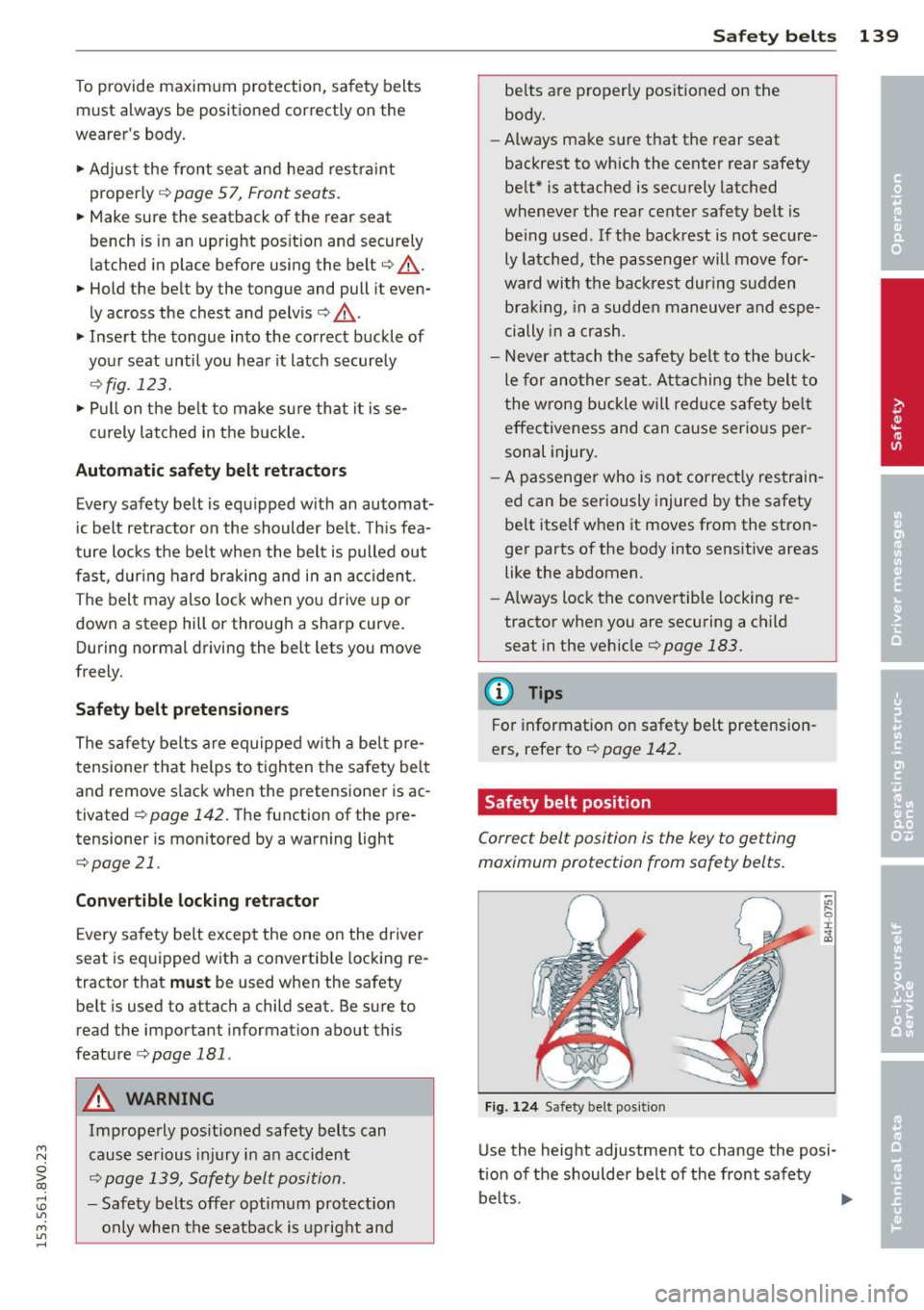
....,
N
0 > co
rl I.O
"' ....,
"' rl
To provide maximum protection, safety belts
must always be positioned correctly on the
wearer's body.
... Adjust the front seat and head restraint
properly
c::> page 5 7, Front seats.
• Make sure the seatback of the rear seat
bench is in an upright position and securely
latched in place before using the belt
c::> ,&..
... Hold the belt by the tongue and pull it even
ly across the chest and pelvis
c::> ,&. .
""Insert the tongue into the correct buckle of
your seat until you hear it latch securely
c::> fig. 123.
.., Pull on the belt to make sure that it is se-
curely latched in the buckle.
Automatic safety belt retractors
Every safety belt is equipped with an automat
ic belt retractor on the shoulder belt . This fea
ture locks the belt when the belt is pulled out
fast, during hard braking and in an accident.
The belt may also lock when you drive up or
down a steep hill or through a sharp curve. During normal driving the belt lets you move
freely.
Safety belt pretensioners
The safety belts are equipped with a belt pre
tensioner that helps to tighten the safety belt
and remove slack when the pretensioner is ac
tivated
c::> poge 142. The function of the pre
tensioner is monitored by a warning light
c::> page 21.
Convertible locking retractor
Every safety belt except the one on the driver
seat is equipped with a convertible locking re
tractor that
must be used when the safety
belt is used to attach a child seat. Be sure to
read the important information about this
feature
c::> poge 181.
A WARNING
Improperly positioned safety belts can
cause serious injury in an accident
o::> page 139, Safety belt position.
-Safety belts offer optimum protection
only when the seatback is upright and
Safety belts 139
belts are properly positioned on the
body.
- Always make sure that the rear seat
backrest to which the center rear safety
belt* is attached is securely latched
whenever the rear center safety belt is
being used. If the backrest is not secure
ly latched, the passenger will move for
ward with the backrest during sudden
braking, in a sudden maneuver and espe
cially in a crash .
- Never attach the safety belt to the buck
le for another seat. Attaching the belt to
the wrong buckle will reduce safety belt
effectiveness and can cause serious per
sonal injury.
- A passenger who is not correctly restrain
ed can be seriously injured by the safety
belt itself when it moves from the stron
ger parts of the body into sensitive areas
like the abdomen.
- Always lock the convertible locking re
tractor when you are securing a child seat in the vehicle
c::> page 183.
(D Tips
For information on safety belt pretension
ers, refer to
c::> page 142.
Safety belt position
Correct belt position is the key to getting
maximum protection from safety belts.
Fig. 124 Safety belt position
Use the height adjustment to change the posi
tion of the shoulder belt of the front safety
belts .
~
Page 142 of 310
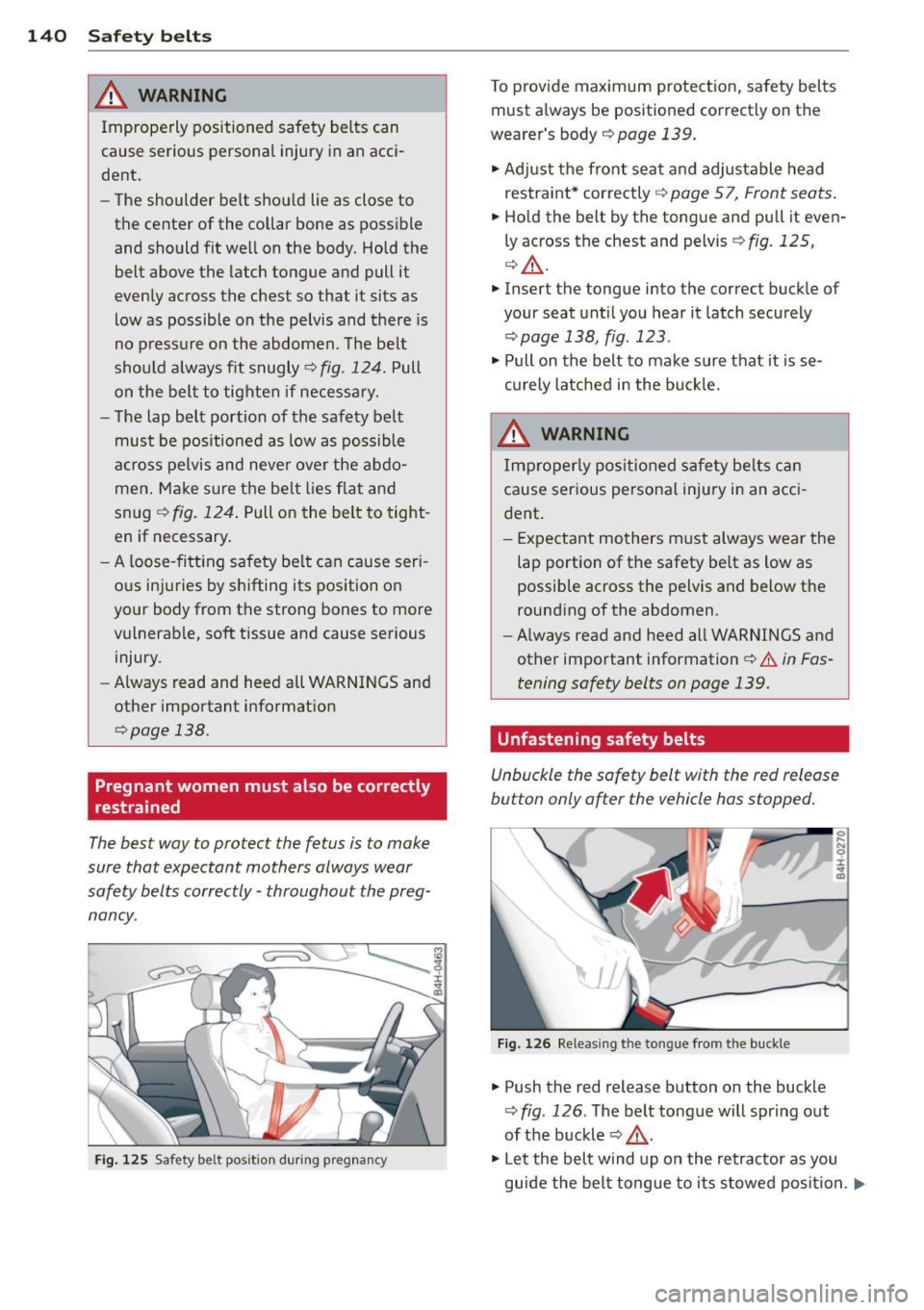
140 Safety belts
_&. WARNING
Improperly positioned safety belts can
cause serious personal injury in an acci
dent.
-
- The shoulder belt should lie as close to
the center of the collar bone as possible
and should fit well on the body. Hold the
belt above the latch tongue and pull it
evenly across the chest so that it sits as
low as possible on the pelvis and there is
no pressure on the abdomen. The belt
should always fit snugly ¢
fig. 124. Pull
on the belt to tighten if necessary.
- The lap belt portion of the safety belt
must be positioned as low as possible
across pelvis and never over the abdo
men. Make sure the belt lies flat and
snug
¢ fig. 124 . Pull on the belt to tight-
en if necessary.
- A loose-fitting safety belt can cause seri
ous injuries by shifting its position on
your body from the strong bones to more
vulnerable, soft tissue and cause serious injury .
- Always read and heed all WARNINGS and
other important information
¢ page 138.
Pregnant women must also be correctly
restrained
The be st way to protect the fe tus is to make
sure that expectant mothers always wear
safety belts correctly -throughout the preg
nancy.
Fig . 125 Saf ety b elt pos it io n durin g pre gnancy
To provide maximum protection, safety belts
must always be pos itioned correctly on th e
wearer's body
¢ page 139.
.. Adjust the front seat and adjustable head
restraint* correctly¢
page 57, Front seats.
.. Hold the belt by the tongue and pull it even
ly across the chest and pelvis¢
fig. 125,
¢Lf1 .
.. Inser t the tongue in to the correct buckle of
your seat until you hear it latch securely
¢page 138, fig. 123.
.,. Pull on the belt to make sure that it is se
curely latched in the buckle.
A WARNING
Improperly positioned safety belts can
cause serious personal injury in an acci
dent.
-
- Expectant mothers must always wear the
lap portion of the safety belt as low as possible across the pelvis and below the
rounding of the abdomen .
- Always read and heed all WARNINGS and
other important information¢.&.
in Fas
tening safety belts on page 139.
Unfastening safety belts
Unbuckle the safety belt with the red release
button only ofter the vehicle has stopped.
,
Fig. 126 Re le asin g the tong ue fro m the buck le
.,. Push the red release button on the buckle
¢ fig. 126 . The belt tongue will spring out
of the buckle ¢
&-
.,. Let the belt wind up on the retractor as you
guide the belt tongue to its stowed position.
II>-
Page 143 of 310
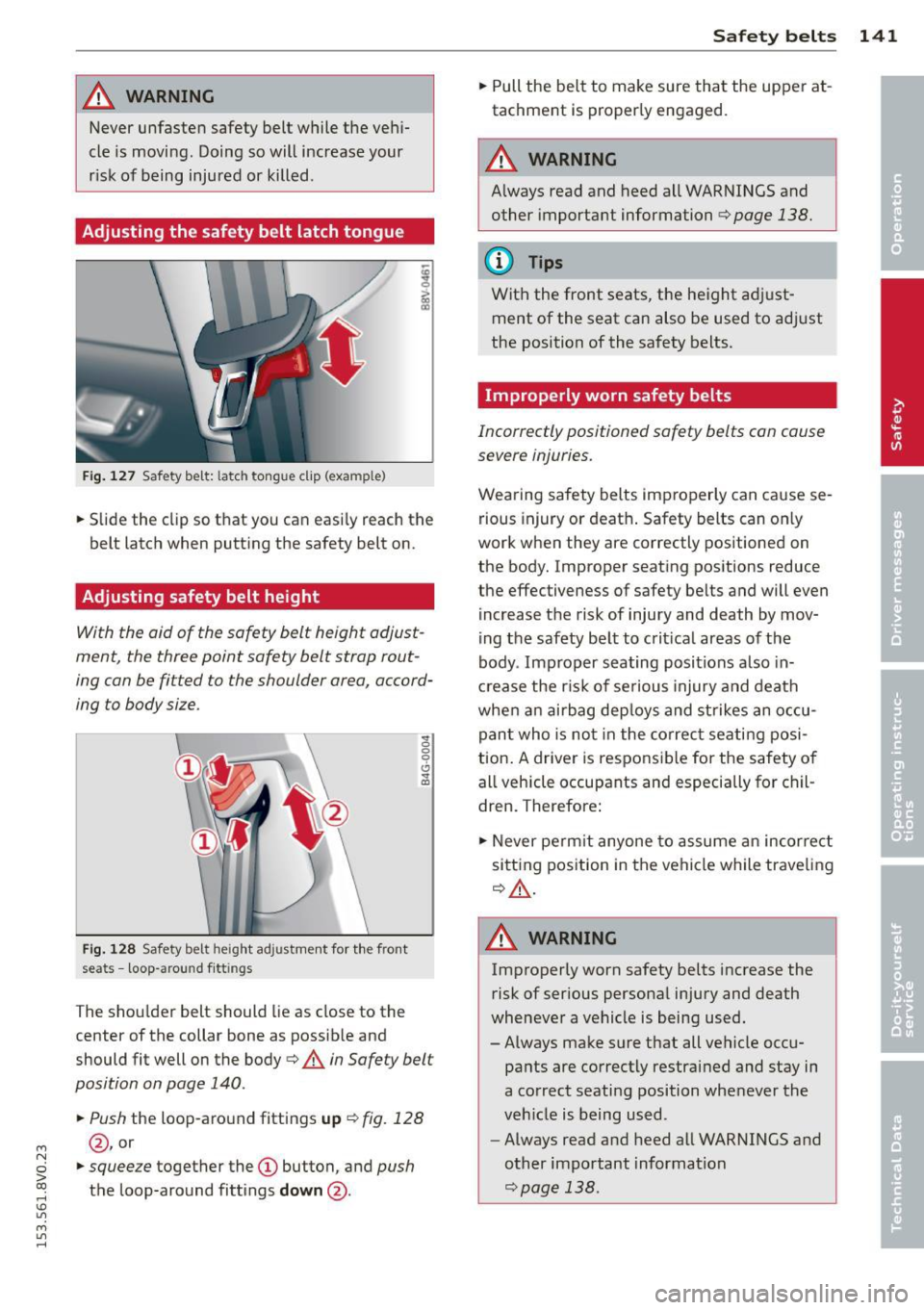
....,
N
0 > co
rl I.O
"' ....,
"' rl
_& WARNING
Never unfasten safety belt while the vehi
cle is movi ng . Doing so will increase your
r isk of being injured or killed .
Adjusting the safety belt latch tongue
Fig. 127 Safety be lt: la tc h ton gue clip (exa mple)
.. Slide the cl ip so that you can easi ly reach the
belt latch when putt ing the safety belt on.
Adjusting safety belt height
With the aid of the safety belt height adjust
ment , the three point safety belt strap rout
ing can be fitted to the shoulder area, accord
ing to body size.
Fi g. 12 8 Safety be lt heig ht ad justment fo r th e fro nt
seats -loop -arou nd fitt ings
;g 0 0 6
" m
The sho ulder belt should lie as close to the
center of the collar bone as possib le and
should fit well on t he body
c::> A in Safety belt
position on page 140 .
.. Push
the loop-a round fittings up c::> fig . 128
@ , or
.. squee ze together the (D button, and push
the loop-around fitt ings down @.
Safety belts 141
.. Pull the belt to make sure that the uppe r at
tachment is proper ly engaged .
A WARNING
Always read and heed all WARNI NGS and
other important information
c::> page 138 .
{I) Tips
With the front seats, the height a djust
ment of the seat can also be used to ad just
the position of the sa fety belts.
Improperly worn safety belts
Incorrectly positioned safety belts can cause
severe injuries.
Wea ring sa fety belts improper ly can cause se
rious injury or deat h. Safety belts can o nly
wor k when they are correctly positioned on
the body. Imprope r seating positions reduce
the effectiveness of safety be lts and will even
increase t he risk of injury and death by mov
ing the safety be lt to crit ica l areas of the
body . Improper seating positions also in
cr ease the r is k of se rio us injury a nd death
whe n an airbag dep loys and st rikes an occu
pan t who is no t in the co rrec t seating posi
t ion . A driver is respons ible for the safety of
all vehicle occupants and especially for chil
dren. Therefore :
.. Never perm it anyone to assume an incor re ct
sitt ing pos ition in the vehicle while trave ling
c::> A .
A WARNING
Im properly worn safety be lts i ncrease the
risk of serious persona l injury and death
wheneve r a ve hicle is being used.
- Always make s ure t hat all vehicle occ u
pa nts are co rrectly restra ined and stay in
a co rrect seati ng position whenever the
veh icle is being us ed .
- Always read and heed all WARNINGS a nd
other impo rtant informat ion
c::> page 138.
Page 144 of 310
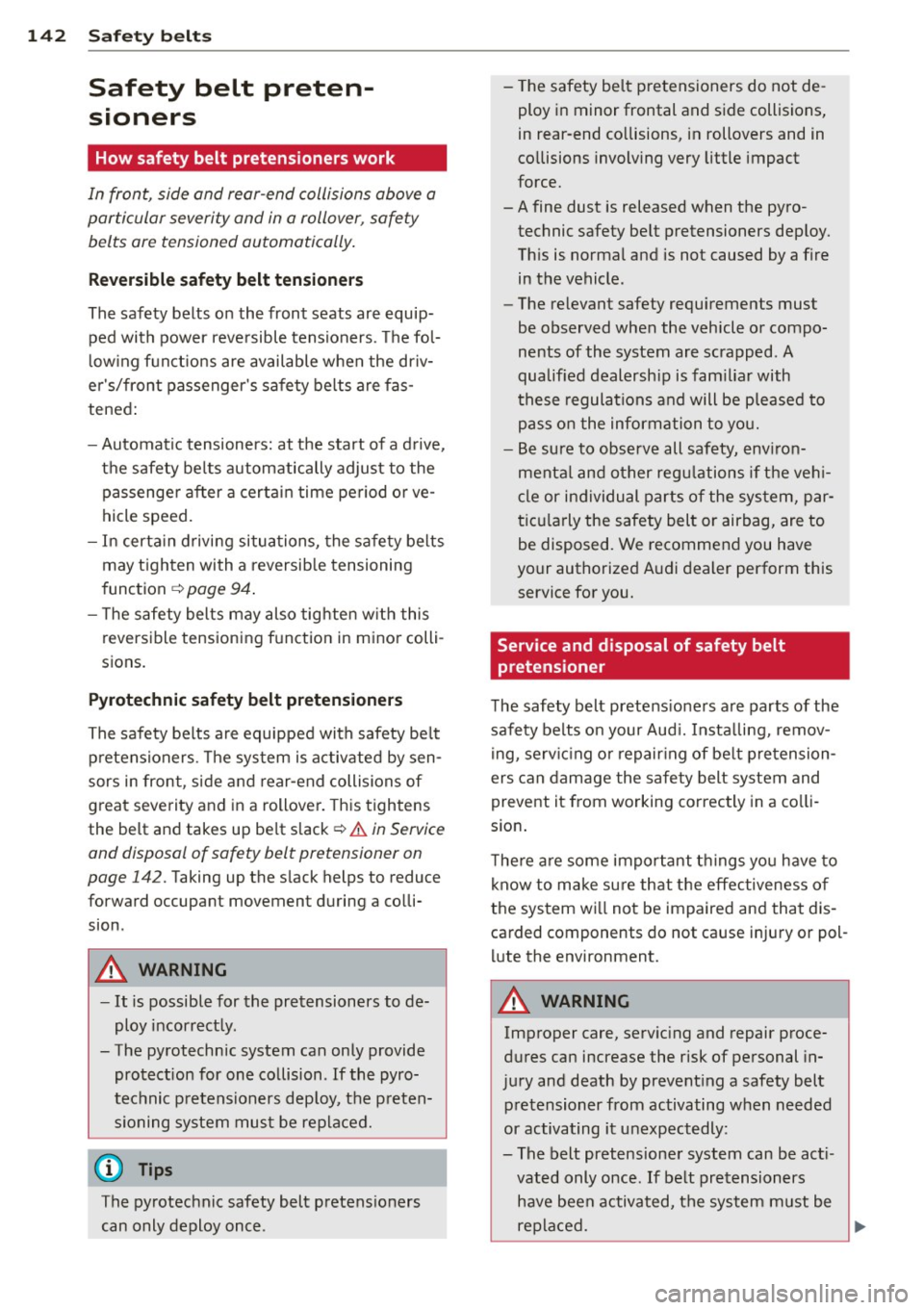
142 Safety belts
Safety belt preten
sioners
How safety belt pretensioners work
In front, side ond rear-end collisions above a
particular severity and in o rollover, safety belts are tensioned automatically.
Reversible safety belt tensioners
The safety belts on the front seats are equip
ped with power reversible tensioners . Th e fo l
lowing functions are available when the driv
er's/front passenger's safety belts are fas
tened:
- Automatic tensioners: at the start of a drive,
the safety be lts automatically adjust to the
passenger after a certain time period or ve
hicle speed.
- In certa in driving situations, the safety belts
may tighten with a reversible tensioning
f unction
~ page 94 .
- The safety belts may also tighten with this
reversible tensioning function in m inor colli
sions.
Pyrotechnic safety belt pretensioners
The safety belts are equipped with safety be lt
p retensioners. The system is activated by sen
sors in front, side and rear -end collisions of
great severity and in a rollover. This tightens
the belt and takes up be lt slack ¢.&.
in Service
and disposal of safety belt pretensioner on
page 142.
Taking up the s lack helps to reduce
forward occupant movement during a colli
sion .
A WARNING
-It is possible for the pretensioners to de
ploy incorrect ly .
- The pyrotechnic system can only provide protection for one collision .
If the pyro
technic pretensioners dep loy, the preten
sioning system must be replaced.
@ Tips
The pyrotechnic safety belt pretens ioners
can only deploy once . -
The safety belt p retensioners do not de
ploy in minor frontal and side collisions,
in rear-end co llisions, in rollovers and in
co llisions involving very little impact
force.
- A fine dust is released when the pyro technic safety belt pretensioners deploy.
This is normal and is not caused by a fire in the vehicle.
- The relevant safety requirements must
be observed when the vehicle or compo
nents of the system are scrapped. A
qualified dealership is fam iliar with
these regulations and will be pleased to
pass on the information to you.
- Be sure to observe all safety, environ
menta l and other regu lations if the veh i
cle or individual parts of the system, par
ticularly the safety belt or airbag, are to
be disposed. We recommend you have
your authorized Audi dealer perform this
service for you.
Service and disposal of safety belt
pretensioner
The safety belt pretens ioners are parts of the
safety belts on your Aud i. Installing, remov
ing, servic ing or repairing of belt pretension
ers can damage the safety belt system and
prevent it from working correctly in a co lli
sion .
T he re a re some important things you have to
know to make su re that the effectiveness o f
the system wi ll not be impaired and that dis
carded components do not cause injury or pol
lu te the environment.
A WARNING
-Improper care, servic ing and repair proce-
dures can increase the risk of personal in
jury and death by prevent ing a safety belt
pretensioner from activating when needed
or activating it unexpectedly:
- The belt pretensioner system can be act i
vated only once. If belt pretensioners have been activated, the system must be
replaced.
~
Page 145 of 310
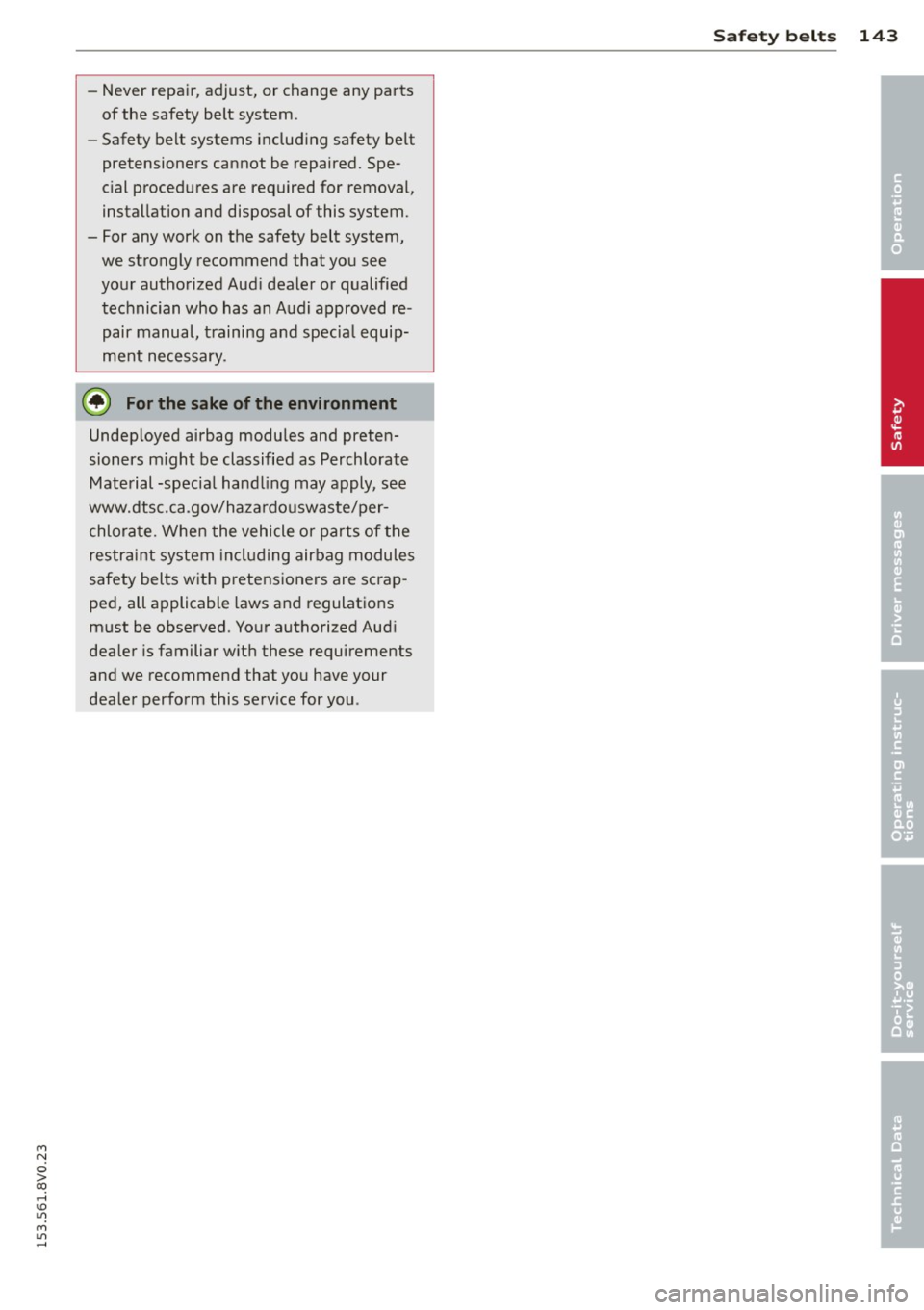
M N
0 > co ,...., \!) 1.1'1
M 1.1'1 ,....,
-Never repair, adjust, or change any parts
of the safety belt system.
- Safety belt systems including safety belt
pretensioners cannot be repaired. Spe
cial procedures are required for removal,
installation and disposal of this system.
- For any work on the safety belt system,
we strongly recommend that you see
your authorized Audi dealer or qualified technician who has an Audi approved re
pair manual, training and special equip
ment necessary .
@) For the sake of the environment
Undeployed airbag modules and preten
sioners might be classified as Perchlorate
Material -special handling may apply, see
www.dtsc.ca .gov/hazardouswaste/per
chlorate. When the vehicle or parts of the
restraint system including airbag modules
safety belts with pretensioners are scrap
ped, all applicable laws and regulations
must be observed. Your authorized Audi
dealer is familiar with these requirements
and we recommend that you have your
dealer perform this service for you .
Safety belts 143
•
•
•
Page 146 of 310
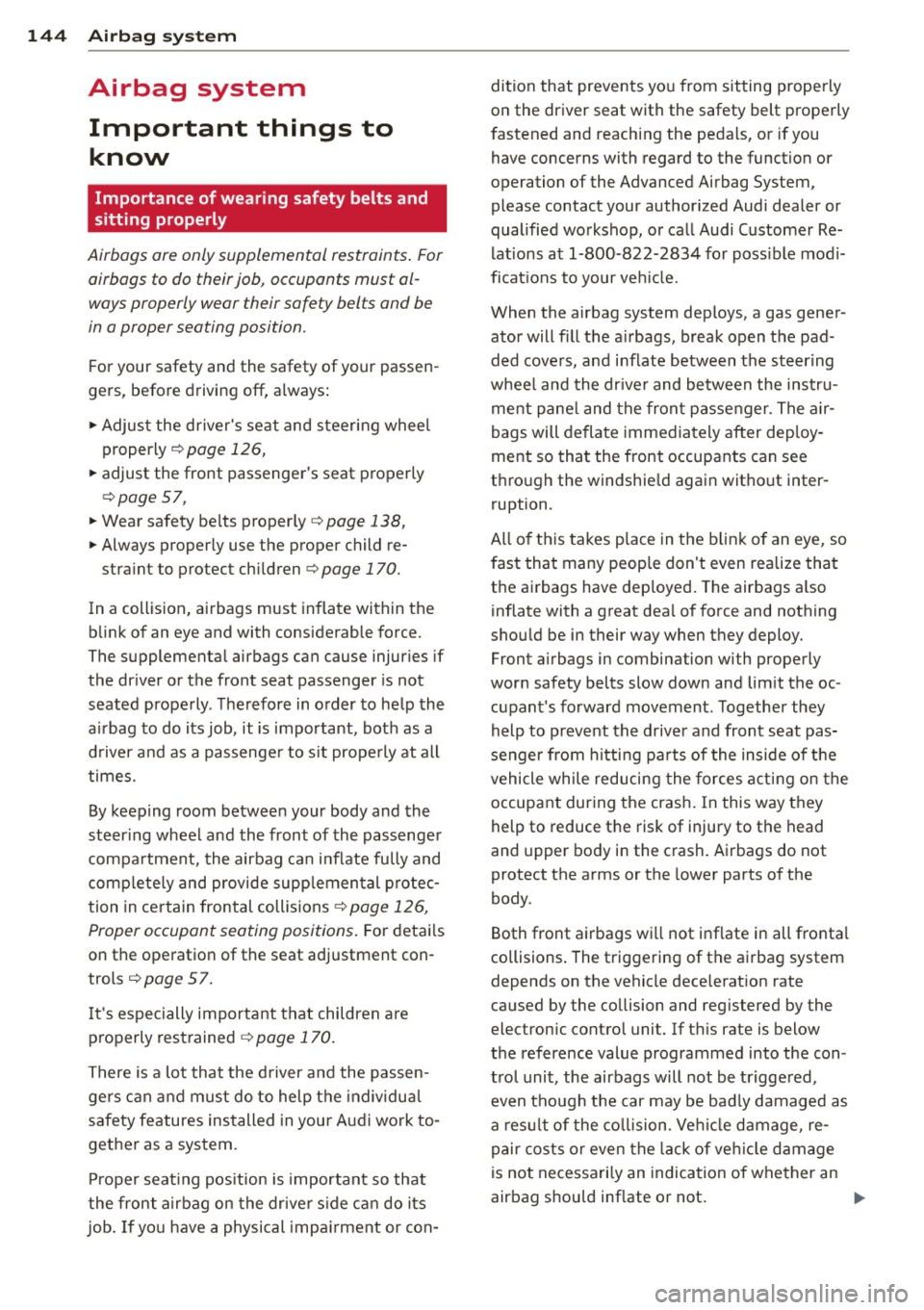
144 Airbag sys tem
Airbag system
Important things to know
Importance of wearing safety belts and
sitting properly
Airbags are only supplemental restraints. For
airbags to do their job , occupants must al
ways properly wear their safety belts and be
in a proper seating position.
F or your safety and the safety of your passen
gers, before driving off, a lways:
• Adjust the driver's seat and steering wheel
properly ¢
page 126,
• adjust the front passenger's seat properly
¢ page 57,
• Wear safety be lts properly ¢ page 138,
• Always properly use the proper child re-
stra int to protect children¢
page 170.
In a collision, airbags must inflate within the
blink of an eye and with considerable force .
The supplementa l airbags can cause injuries if
the dr iver or the front seat passenger is not
seated properly . Therefore in order to he lp the
a ir bag to do its job, it is important, both as a
d river and as a passenge r to sit prope rly at all
times.
By keeping room between your body and the
steering wheel and the front of the passenge r
compartment, the airbag ca n inflate fully and
comp letely and provide supp lemental protec
tion in ce rtain frontal collisions¢
page 126,
Proper occupant seating positions .
For detai ls
on the operation of the seat adjustment con
t rols ¢
page 57.
It's especially important that children a re
properly restrained ¢
page 170.
There is a lot that the driver and the passen
gers can and must do to help the individua l
safety features installed in your A udi work to
gether as a system.
P rope r seat ing pos ition is important so that
the front airbag on the drive r side can do its
job. If yo u have a physical impa irment or con- dition that prevents yo
u from sitting properly
o n the driver seat with the safety belt properly
fastened and reaching the pedals , or if you
have concerns with regard to the function or
operation of the Advanced Airbag System ,
please contact your author ized Audi dealer or
qualified workshop, o r call Audi Customer Re
lations at 1-800-822-2834 fo r poss ible modi
fica tions to your ve hicle.
When the airbag system deploys, a gas gener
ator will f il l the a irbags, break open t he pad
ded cove rs, and inflate between the steering
whee l and the dr iver and between the instru
ment pane l and the fron t passenger. The a ir
bags will deflate immediately after dep loy
ment so tha t the front occupants can see
t hr ough the windshie ld again witho ut inter
ruption .
All of th is takes p lace in the b link o f an eye, so
fast that many peop le don't even realize tha t
the airbags have deployed. The airbags a lso
inflate with a great dea l of force and nothing
shou ld be in their w ay when they deploy.
Front a irbags in combination with properly
wor n safety belts slow down and lim it the oc
cupant's forward movement . T ogether they
help to prevent the drive r and front seat pas
senger from hitting pa rts of the inside of t he
vehicle while reducing the forces acting on the
occupant dur ing the crash . In this way they
help to reduce the risk of injury to the head
and upper body in the crash. A irbags do not
protect the arms or the lower parts of the
body.
Both front airbags wi ll not inflate in all fronta l
collisions . The triggering of the airbag system
depends on the vehicle dece lerat ion rate
ca used by the co llision and registered by the
electron ic control unit. If th is rate is below
the reference value programmed into the con
t rol unit , the airbags will not be trigge red,
even though the car may be badly damaged as
a res ult of the co llision . Ve hicl e damage, re
pair costs o r even the lack of ve hicle damage
is not necessari ly an indication of whe ther an
airbag shou ld inflate or not .
IJll-
Page 147 of 310
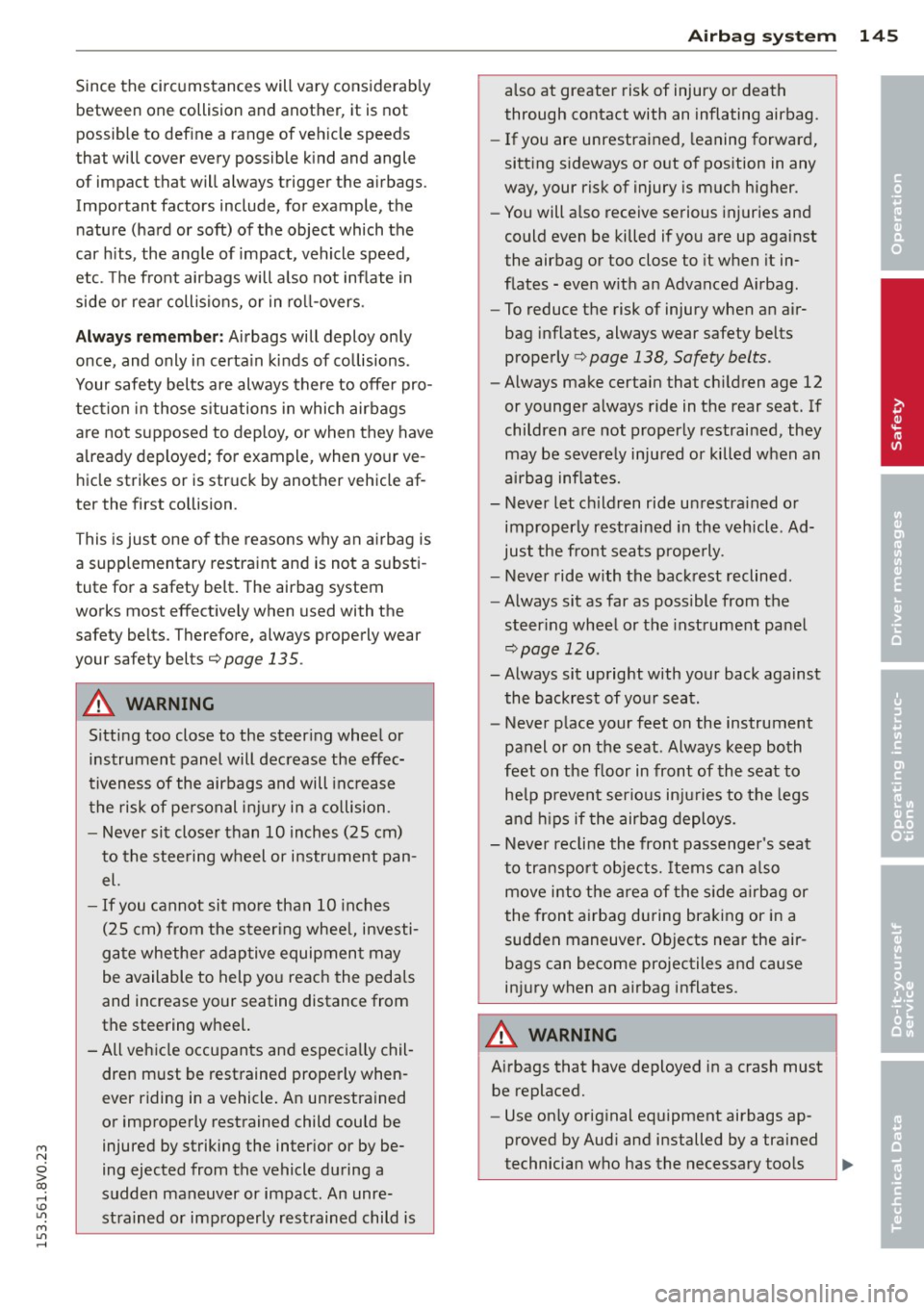
Airbag system 145
Since the circumstances will vary considerab ly
also at greater risk of injury or death
between on e collision and another , it is not
through contact with an inflating airbag .
possible to define a range of veh icle speeds
-If you are unrestrained, leaning forward,
that will cover every possible k ind and angle
sitting sideways or out of position in any
of impact that will always trigger the a irbags .
way, your risk of injury is much higher.
Important factors include, for example, the -You will a lso receive serious injuries and
nature (hard or soft) of the object which the could even be killed if you are up against
•
car h its, the ang le of impact, vehicle speed ,
• the airbag or too close to it when it in-
etc. The front airbags will a lso not inflate in
flates - even with an Advanced A irbag.
side or rea r collisions, or in ro ll-overs .
-To reduce the risk of injury when an air-
Alwa ys re memb er: Airbags will deploy only bag inflates, always wear safety belts
once, and only in certa in kinds of co llisions. properly
c::;, page 138, Safety belts
.
Your safety belts are always there to offe r pro- -
Always make certain that ch ildren age 12
tection in those s ituations in which airbags or younger always ride in the rear seat. If
are not s upposed to deploy , or when they have children a
re not properly restrained , they
already deployed ; for example , when your ve- may be severe
ly inju red or killed when an
hide strikes or is struck by another vehicle af- airbag inf
lates.
ter the first collision . -
Never let ch ildren ride un restra ined o r
This is just one of the reasons why an a irbag is improperly restrained
in the vehicle . Ad-
just the front sea ts prope rly.
a supp lementary restraint and is not a s ubsti -
-Never ride with the back rest reclined .
tute for a safety belt . The airbag system
-Always sit as far as possible from the
works most effect ively when used with the
steering whee l or the instrument panel
safety belts. Therefore, always properly wear
c::;, page 126 . your safety belts c::;, page 135 .
- Always sit upright with your back against
A WARNING the backrest of yo ur seat.
- Never p lace your feet on the instrument
Sitting too close to the steer ing whee l or
panel or on the seat . Always keep both
instrument panel will dec rease the effec-
feet on the floor in front of the seat to
tiveness of the airbags and will inc rease
help prevent serious in ju ries to the legs
the risk of pe rsonal injury in a co llision.
and hips if the airbag deploys.
- Never si t closer than 10 inches (2S cm)
-Never recline the front passenger's sea t
to the stee ring wheel or instr ument pan-
to transport objects. Items can a lso
el. move into the area of the s ide a irb ag or
- If you cannot si t mo re than 10 inches
the front airbag during bra king or in a
( 2 5 cm) from the steer ing whee l, investi-
sudden maneuver. Objects near the air-
ga te whethe r adap tive equipmen t may
bags can become projectiles and cause
be available to help you reach the pedals injury when an airbag inflates.
and increase your seating distance from
the steering wheel.
A WARNING
- All veh icle occupants and especia lly chil -
dren m ust be restrained properly when- A
irbags that have deployed in a crash must
ever riding in a vehicle . An unrestra ined be replaced.
or improperly restrained child could be -
Use on ly orig inal equipment airbags ap-
M injured by striking the inter ior or by be- proved by Audi and installed by a trained • N technician who has the necessary too
ls ~ 0 ing ejected from the vehicle during a > co sudden maneuver or impact . An unre-,...., \!) ..,., strained or imp roperly rest rained child is M ..,., ,....,
Page 148 of 310
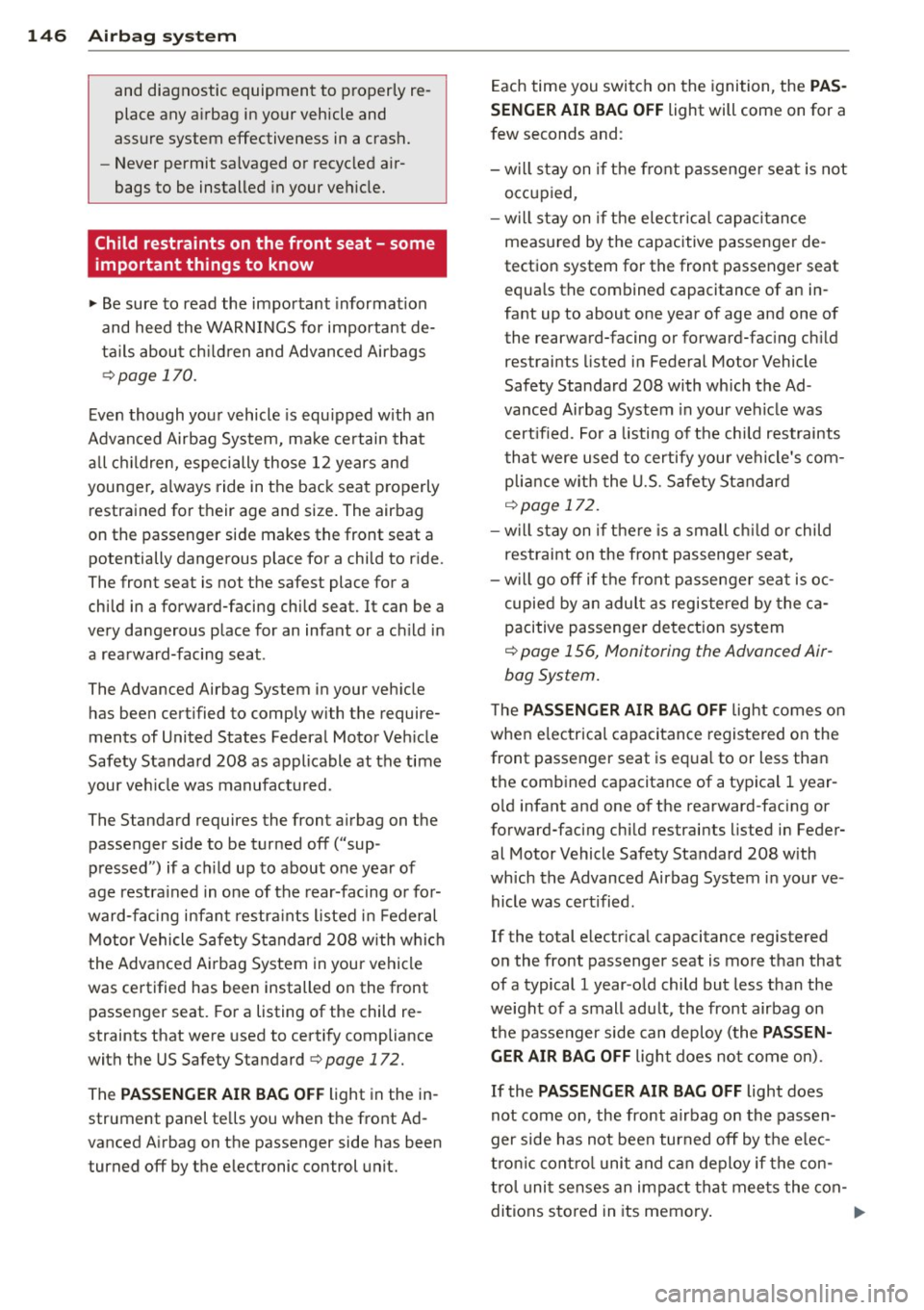
146 Airbag sys te m
and dia gnostic equipmen t to pro perly re
place any a irbag in y our vehicle and
assure system eff ectiveness in a crash.
- Never permit salvaged or recycle d air
bags to be installed in your veh icle.
Child restraints on the front seat - some
important things to know
~ Be sure to read the important informat ion
and heed the WARNINGS for important de
ta ils about ch ild ren and Advanced Airbags
Qpage 170.
Even though your vehicle is equ ipped with an
Advanced Airbag System, make certain that
all c hildren, especially those 12 years and
younger, a lways ride in the back seat properly
restrained for their age and size . The airbag
on the passenger side makes the front seat a potentially dangerous place for a child to ride.
The front seat is not the safest place for a
child in a forward-facing child seat. It can be a
ve ry dangerous place for an infant or a ch ild in
a rearward-facing seat.
The Advanced Airbag System in your veh icle
has been certified to comply with the require
ments of United States Federal Motor Veh icle
Safety Standard 208 as applicable at the time
your ve hicle was manufactured.
The Standard requires the front a irbag on the
passenger side to be turned off ("sup
p ressed") if a ch ild up to about one year of
age restra ined in one of the rear-facing o r fo r
ward-facing infan t restra ints listed in Federal
M otor Vehicle Safety Standard 208 with w hich
the Advanced A irbag System in your vehicle
was certified has been installed on the front
passenger seat. Fo r a listing of the child re
straints that were used to certify compliance
with the US Safety Standard
Q page 172.
The PASSENGER AIR BAG OFF light in the in
strument panel te lls you when the front Ad
vanced Airbag on the passenger side has been turned off by the e lectronic control unit. E
ach time you switch on the ignition, the
PAS
SENGER AIR BAG O FF
light will come on for a
few seconds and :
- w ill stay on if the front passenge r seat is not
occupied,
- w ill stay on if the e lec trica l ca pa citance
meas ured by the capacitive passenger de
tection system for the front passenger seat equa ls the combined capacitance of an in
fant up to about one year of age and one of
the rearward-facing or forward-fac ing ch ild
restraints listed in Federal Motor Vehicle
Safety Standard 208 with wh ich the Ad
vanced Airbag System in your vehicle was
cert ified . For a listing of the chi ld restraints
tha t were used to certify you r vehi cle's com
p lia nce w it h t he U.S. Safety Standard
Q page 172.
-w ill stay on i f there is a small ch ild or child
restraint on the front passenge r seat,
- will go off if the front passenger seat is oc
cupied by an adult as registered by the ca
pacitive passenger de tection system
c::> page 156, Monitoring the Advanced Air·
bag System.
The PASSENGER AIR BAG OFF light comes on
when e lectrica l capacitance registered on the
front passenger seat is eq ua l to or less tha n
the comb ined capacitance of a typica l 1 year
o ld infant and one of the rearward-facing or
forward-facing chi ld restraints listed in Feder
al Motor Vehicle Safety Standard 208 with
wh ich the Advanced Airbag System in your ve
hicle was certified.
If the total electr ica l capacitance registered
on the front passenger seat is more than that
of a typical 1 year -o ld child but less than the
weight of a small adult , the front airbag on
t h e passenger side can deploy (the
PASSEN
GER AIR BAG OFF
light does not come on).
If the
PASSENGER AIR BAG OFF light does
not come on, the front airbag on the passen
ger side has not been turned off by t he e lec
t ro ni c cont ro l unit and can deploy if the con
t ro l uni t se nses an impact tha t mee ts the con-
di tions stored in its memory .
1J1>
Page 149 of 310
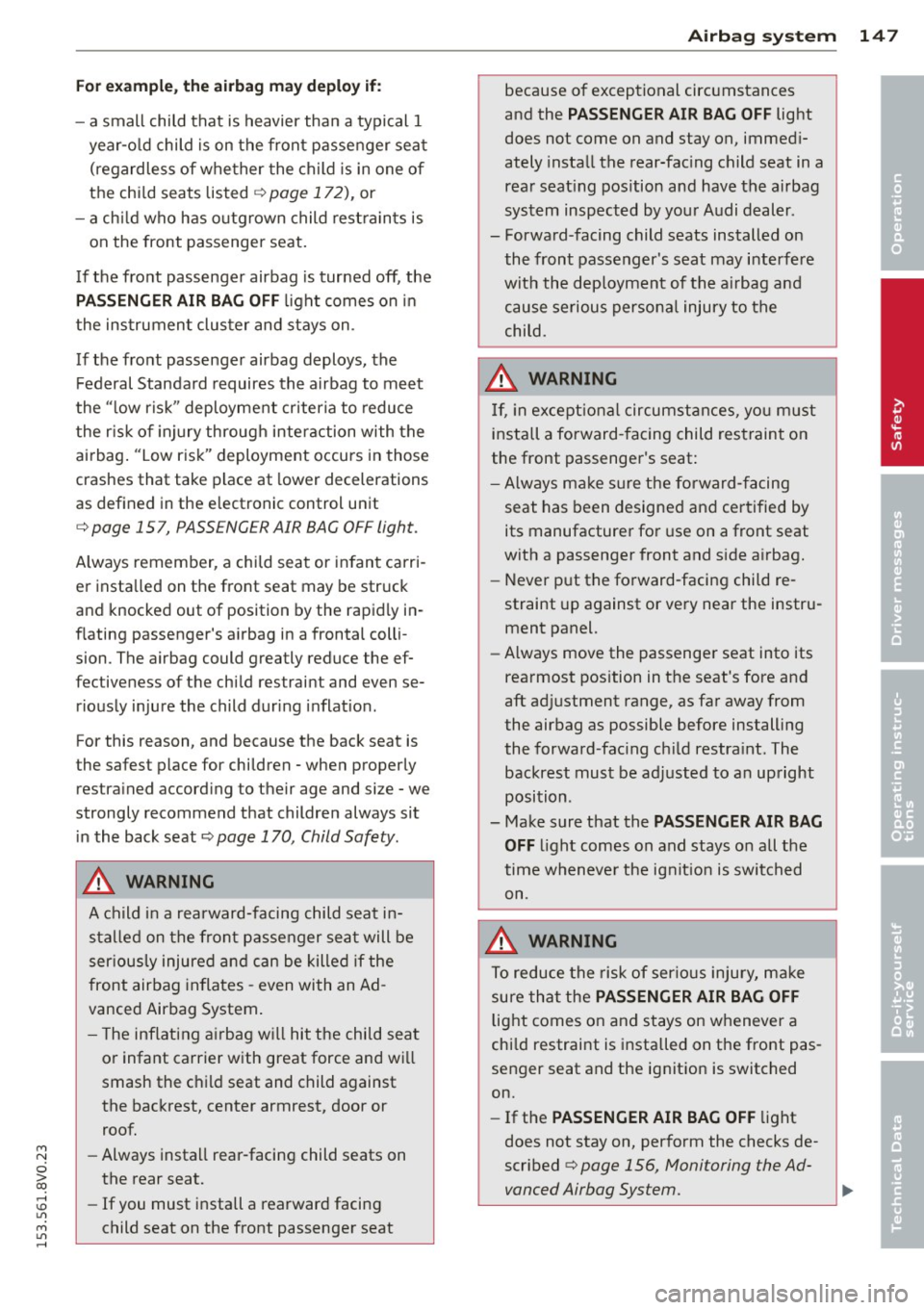
M N
0 > co ,...., \!) 1.1'1
M 1.1'1 ,....,
Fo r exa mple, the a irbag may depl oy if:
-a small child that is heavier than a typical 1
year-o ld child is on the front passenger seat
(regardless of whether the child is in one of
the chi ld seats listed
page 172), or
- a ch ild who has outgrown child rest raints is
on the front passenger seat.
If the front passenger airbag is turned off, the
P ASS ENGER AIR B AG OFF light comes on in
the instrument cluster and stays on.
If the front passenger airbag deploys, the
Federal Standard requires the airbag to meet
the "low risk" deployment criter ia to reduce
the r isk of injury through interaction with the
airbag. "Low risk" deployment occurs in those
crashes that take place at lower decelerations
as defined in the electronic control unit
r::> page 15 7, PASSENGER AIR BAG OFF light.
Always remember, a chi ld seat or infant carri
er insta lled on the front seat may be struck
and knocked out of position by the rapidly in
flating passenger's airbag in a frontal colli
sion. The airbag could greatly reduce the ef
fectiveness of the child restraint and even se
riously injure the child during inflat ion.
For this reason, and because the back seat is
the safest place for children -when properly
restrained according to their age and size - we
strongly recommend that children always sit in the back seat
r::> page 170, Child Safety .
A WARNING
A child in a rearward-facing child seat in
stalled on the front passenger seat will be
ser iously injured and can be killed if the
front airbag inflates -even with an Ad
vanced Airbag System .
- T he inflating airbag will hit the child seat
or infant carrier with great force and wi ll
smash the child seat and child against
the backrest, center armrest, door or roof.
- Always install rear-facing child seats on
the rear seat.
- If you must install a rearward facing
child seat on the front passenger seat
-
A irbag system 147
because of exceptional circumstances
and the
PA SSENGER AIR BAG OFF light
does not come on and stay on, immed i
ately install the rear-fac ing child seat in a
rear seat ing pos ition and have the airbag
system inspected by your A udi dealer.
- Forward-facing child seats installed on the front passenger's seat may interfere
with the dep loyment of the a irbag and
cause serious persona l injury to the
child.
A WARNING
If, in except iona l circumstances, you must
install a forward -facing child restraint on
the front passenger's seat:
- Always ma ke s ure the forward-facing
seat has been designed and certified by its manufacturer for use on a front seat
with a passenger front and s ide a irbag.
- Never put the forward-facing child re
straint up against or very near the instru
ment panel.
- Always move the passenge r seat into its
rea rmost pos ition in the seat's fore and
aft ad justment range, as far away from
the airbag as possible before installing
the forward-fac ing ch ild restra int. The
backrest must be adjusted to an upright
position.
- Make sure that the
PASSENGER AIR BAG
OFF
l ight comes on and stays on all the
time wheneve r the ig nit ion is switched
on.
A WARNING
To reduce the ri sk of ser ious injury, ma ke
sure that the
PASSENGER AIR BAG OFF
light comes on and stays on whenever a
chi ld restraint is installed on the front pas
senger seat and the ignition is switched
on.
- If the
PA SSENGER AIR BAG OFF light
does not stay on, perform the checks de
scribed¢
page 156, Monitoring the Ad-
vanced Airbag System.
~
•
•
•
Page 150 of 310
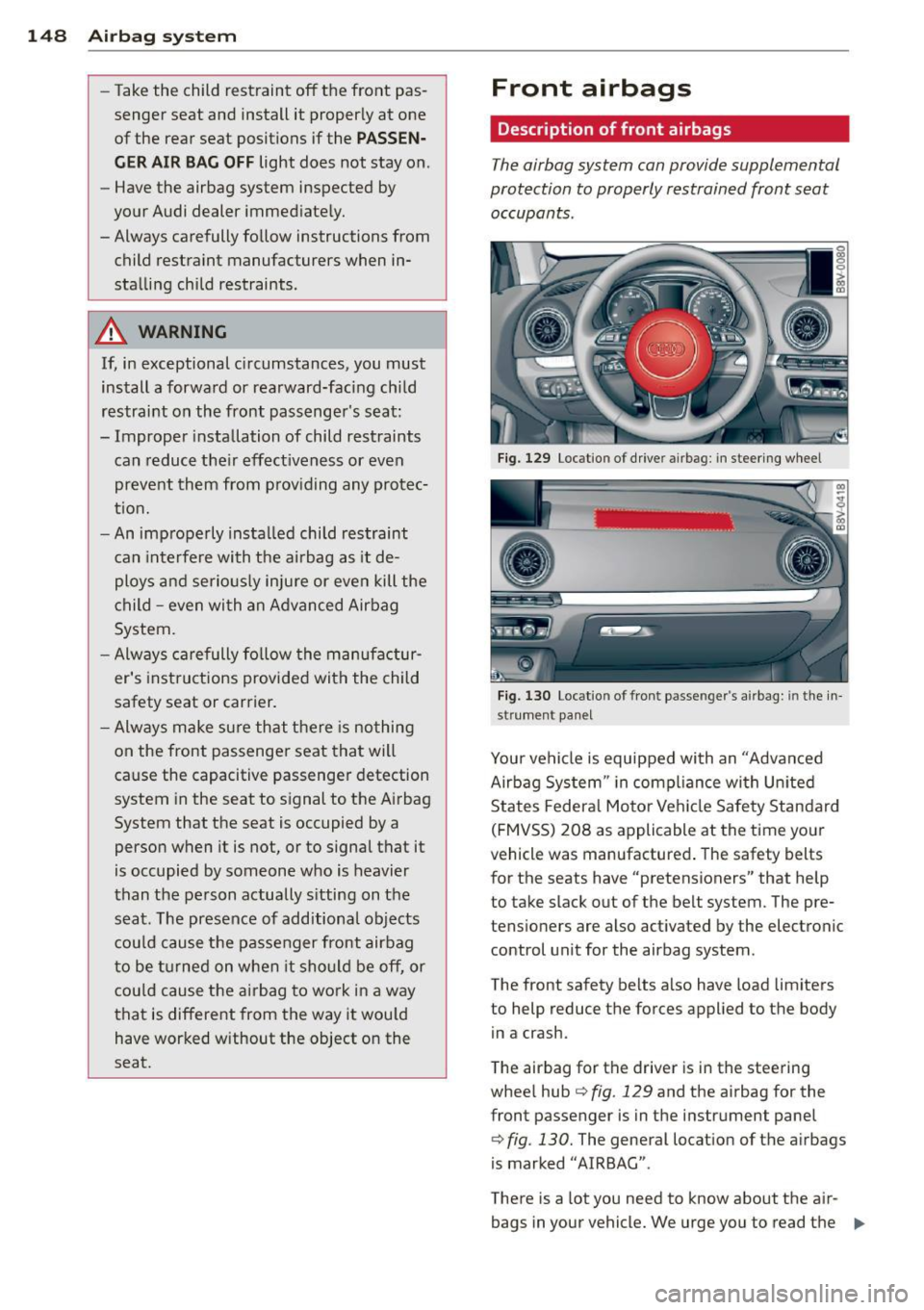
148 Airbag system
-Take the child restraint off the front pas
senger seat and install it properly at one
of the rear seat positions if the
PASSEN
GER AIR BAG OFF
light does not stay on .
- Have the airbag system inspected by
your Audi dealer immediately.
- Always carefully follow instructions from
child restraint manufacturers when in
stalling child restraints .
A WARNING ,.
If, in exceptional circumstances, you must
install a forward or rearward-facing child
restraint on the front passenger's seat:
- Improper installation of child restraints
can reduce their effectiveness or even
prevent them from providing any protec
tion.
- An improperly installed child restraint
can interfere with the airbag as it de
ploys and seriously injure or even kill the
child -even with an Advanced Airbag
System.
- Always carefully follow the manufactur
er's instructions provided with the child
safety seat or carrier.
- Always make sure that there is nothing
on the front passenger seat that will
cause the capacitive passenger detection
system in the seat to signal to the Airbag
System that the seat is occupied by a person when it is not, or to signal that it
is occupied by someone who is heavier
than the person actually sitting on the
seat. The presence of additional objects
could cause the passenger front airbag
to be turned on when it should be off, or
could cause the airbag to work in a way
that is different from the way it would have worked without the object on the
seat.
Front airbags
Description of front airbags
The airbag system can provide supplemental
protection to properly restrained front seat occupants .
Fig. 129 Loc atio n of drive r ai rb a g : i n steering wheel
Fig. 130 Loc atio n of fro nt passe nge r's airbag: in the in
st rumen t panel
Your vehicle is equipped with an "Advanced
Airbag System" in compliance with United
States Federal Motor Vehicle Safety Standard
(FMVSS) 208 as applicable at the time your
vehicle was manufactured . The safety belts
for the seats have "pretensioners" that help to take slack out of the belt system. The pre
tensioners are also activated by the electronic control unit for the airbag system.
The front safety belts also have load limiters to help reduce the forces applied to the body
in a crash.
The airbag for the driver is in the steering
wheel hub
c:> fig. 129 and the airbag for the
front passenger is in the instrument panel
c::;, fig. 130. The general location of the airbags
is marked "AIRBAG".
There is a lot you need to know about the air
bags in your vehicle. We urge you to read the
II>